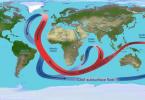Test on the topic: “Reproduction and individual development of organisms” 9th grade.
Compiled by biology teacher MBOU Arkhangelsk Secondary School Ogloblina V.A.
Option 1
1. Forms of asexual reproduction include:
A)sporulation b) parthenogenesis c) hermaphroditism
2. The phase of mitosis during which sister chromatids separate and become daughter chromosomes:
a) prophase b) telophase c) metaphase d)anaphase
3.What are the non-motile male reproductive cells of plants called:
A)sperm b) gametes c) spores d) sperm
4. Conjugation of homologous chromosomes occurs during:
a) metaphase II of meiosis b) prophase I of meiosis c) prophase II of meiosis d)metaphase I of meiosis
5.What are the names of the sexual reproductive organs of plants:
a) subsidiary organs b)generative organs c) genitals d) vegetative organs
6. A zygote is:
a) male reproductive cell b) egg c)fertilized egg d) female gamete
7.What does a chromosome consist of:
a) from centromeres b)from chromatids c) from microtubules d) from spindles
8. From the ectoderm is formed:
A)nervous system b) circulatory system c) excretory system d) lungs
Answers:
Option 2.
Test tasks with the choice of one correct answer.
1. The storage tissue of the endosperm of the seed of flowering plants has a set of chromosomes:
a) tetraploid b) haploid c) diploid d)triploid
2. What happens in telophase:
a) formation of the fission spindle b)formation of new nuclei and cytokinesis
c) separation of chromosomes d) movement of chromosomes to the center of the cell
3.In anaphase of mitosis occurs:
a) divergence of bichromatid chromosomes to the poles of the cell b) spiralization of chromosomes
V)separation of chromatids to the cell poles d) despiralization of chromosomes
4. During the process of neurulation, the following is formed:
A)neural tube b) mesoderm c) ectoderm d) gastrula
5. The process of formation of male germ cells in animals and humans:
a) mitosis b) amitosis c)spermatogenesis d) ovogenesis
6. The sequence of stages of mitosis is as follows:
a) prophase, anaphase, telophase, metaphase
b) prophase, telophase. metaphase, anaphase
V)prophase. metaphase, anaphase, telophase
d) prophase, metaphase, telophase, anaphase
7.What is the name of a cell that contains a double set of chromosomes:
a) somatic b)diploid c) haploid d) eukaryotic
8. During meiosis, daughter cells have a set of chromosomes:
A) n b)2nV)3nG)4n
Match and write down the answers in the table
Answers:
Used sources:
1.I.N.Ponomareva, O.A.Kornilova, N.M.Chernova. “Fundamentals of General Biology” textbook 9th grade ed. "Ventana-Count" 2004.
2.L.A.Tepaeva. "Biology. Organization of control in the lesson. KIM" ed. "Teacher" 2010.
3.I.R.Grigoryan. edited by L.A. Popova. “KIM. Biology 9th grade” ed. "WAKO" 2011.
4.N.A.Bogdanov. "Unified State Examination. Biology." Typical test tasks" ed. "Exam" Moscow 2011.
Option 1
Part A
a) doubles
b) is halved
c) turns out to be the same
d) changes with age
2. The essence of meiosis is:
a) 24 chromosomes
b) 8 chromosomes
c) 16 chromosomes
d) 32 chromosomes
What sequence of stages of individual development is typical
For the cabbage white butterfly?
a) egg → butterfly
b) egg → butterfly → larva
c) egg → larva → pupa → butterfly
d) egg → pupa → larva → butterfly
5. The process of individual development of the organism:
a) phylogeny b) cell cycle c) ontogeny d) embryogenesis
6. The sequence of mitosis phases is as follows:
a) prophase, telophase, anaphase, metaphase
b) prophase, metaphase, telophase, anaphase
c) prophase, metaphase, anaphase, telophase
d) prophase, telophase, metaphase, anaphase
There is a specific relationship between the objects and processes listed in the columns of the table below.
What object should be entered in the blank space in this table?
a) mitochondria
b) cell center
c) ribosome
d) vacuole
Figures (1,2,3,4) show one of the methods of vegetative
Reproduction. What is it called?
a) propagation by leaf cuttings
b) propagation by layering
c) propagation by root cuttings
d) reproduction by whiskers
Asexual reproduction is widespread in nature, as it promotes
a) rapid population growth
b) the occurrence of changes in individuals of the species
c) the appearance of modification variability
d) adaptation of organisms to unfavorable environmental conditions.
In which method of reproduction is the genotype of the offspring an exact copy of the genotype of the parents?
a) sexual
b) seed
c) vegetative
d) with the participation of gametes.
Part B
Choose several correct answers.
How is mitosis different from meiosis?
a) two divisions occur one after another
b) one division occurs, consisting of four phases
c) two daughter cells are formed, identical to the mother one
d) four haploid cells are formed
e) homologous chromosomes diverge to the cell poles,
2. Characteristics of gametes - sperm:
1) immobility
2) active mobility
4) there is no supply of nutrients
6) supply of nutrients in the cytoplasm (yolk)
7) gamete is large
8) the gamete is small.
3.Features characteristic of meiosis:
1) two daughter cells,
2) four daughter cells,
3) one division,
4) two divisions,
5) diploid daughter cells,
6) haploid daughter cells.
4. Is the judgment true (if true, mark this judgment with a “+” sign, if not - “-”)
1) A chromosome is a complex of one DNA molecule with proteins, i.e. consists of one chromatid.
2) Interphase is the period of the cell cycle between cell divisions.
3) Amitosis is an indirect cell division, in which the nucleus is divided by constriction and a uniform distribution of hereditary material is ensured.
4) Crossing over is a crossover between homologous chromosomes. accompanied by the exchange of relevant areas.
5) As a result of meiosis, cells are formed that are exact copies of the mother cell.
6) The separation of the cytoplasm occurs during anaphase of mitosis.
Arrange and label the stages of the cell cycle of a cell undergoing mitosis (number of chromosomes, using the formula where n is the number of chromosomes,





1 2 3 4 5
Part C
Fill in the missing words
The essence of fertilization is that fusion occurs _________________
and ______________________, and then _____________________ is formed
Test on the topic “Reproduction and individual development of organisms”
Option 2
Part A
1) During the process of cell division, the most significant transformations undergo:
a) ribosomes
b) chromosomes
c) mitochondria
d) lysosomes
2) How to explain the constancy of the number of chromosomes in individuals of the same species?:
a) diploidity of organisms
b) the process of cell division
c) haploidy of organisms
d) processes of fertilization and meiosis
3) The nucleus of the sperm of an animal contains 16 chromosomes, and the nucleus of the egg of this animal contains:
a) 24 chromosomes
b) 8 chromosomes
c) 16 chromosomes
d) 32 chromosomes
Part B.
1 2 3 4 5
Part C
Fill in the missing words
The very first cell that gives rise to a new organism during sexual reproduction is called __________________
It is formed as a result of _________________________________
Test on the topic “Reproduction and individual development of organisms”
Option 1
Part A
1. Thanks to mitosis, the number of chromosomes in the cells of the body:
a) doubles
b) is halved
c) turns out to be the same
d) changes with age
2. The essence of meiosis is:
a) in the formation of cells with a diploid set of chromosomes
b) doubling the amount of DNA in body cells
c) restoration of the full set of chromosomes in cells
d) the formation of gametes with a haploid set of chromosomes
3. The nucleus of an animal’s egg contains 16 chromosomes, and the nucleus of the sperm of this animal:
a) 24 chromosomes
b) 8 chromosomes
c) 16 chromosomes
Biology test.
9th grade.
1 option
2. Write down the biological information on a separate piece of paper.
Biology test.
9th grade.
Topic: “Reproduction and individual development of organisms”
Option 2
- On a separate piece of paper, write down the numbers from 1 to 10.
Next to each number, put a + if the statement is true, and a - sign if the statement is false.
- Female gamete without flagellum.
2. On a separate piece of paper, write down the numbers from 1 to 10.
Next to each number, write down the correct answer.
2. Write down the biological essence of crossing over on a separate piece of paper.
Biology test.
9th grade.
Topic: “Reproduction and individual development of organisms”
1 option
- There are two main types of reproduction: sexual and asexual.
- Sexual reproduction is the self-reproduction of organisms in which one individual participates.
- The male gamete can be with or without a flagellum.
- Vegetative reproduction is an example of asexual reproduction.
- Prokaryotic cells reproduce by simply dividing in two.
- Chromosome duplication and chromatid formation occur during prophase.
- The process of cell division, as a result of which half as many chromosomes are formed in the nucleus, is called mitosis.
- As a result of meiosis, one cell produces four cells with a haploid set of chromosomes.
- Meiosis consists of two divisions.
- In utero, postembryonic development of the body occurs in the mother's body.
2. Write down the correct answer.
- The female gamete is called ______________.
- A male gamete without a flagellum is called ___________________.
- Sporulation is an example of ______________ reproduction.
- The ability to repeat in daughter organisms the unchanged hereditary qualities of the parent, i.e. reproduce homogeneous offspring, a unique property of ________________ reproduction.
- The first phase of mitosis is called ___________________.
- The chromatids are connected by a constriction called ___________________.
- The process of exchanging sections of DNA strands, during which new combinations of genes are formed, is called ______________.
- Cell division that results in the formation of sex gametes is called _______________.
- Cells with a single set of chromosomes are called _________________.
- The development of an individual (individual), determined by heredity and the influence of environmental conditions, is called ______________.
2. Write down the biological essence of sexual reproduction.
Biology test.
9th grade.
Topic: “Reproduction and individual development of organisms”
Option 2
1. Next to each number, put + if the statement is true, and a - sign if the statement is false.
- Reproduction is the main property of living organisms to reproduce their own kind, ensuring the continued existence of the species.
- Asexual reproduction is the self-reproduction of organisms in which two individuals participate.
- Female gamete without flagellum.
- Budding is an example of asexual reproduction.
- The nuclei of eukaryotic cells divide by mitosis.
- The separation of centromeres and the divergence of chromatids to the cell poles occurs during prophase.
- The process of cell division, as a result of which the same number of chromosomes is formed in the nucleus, is called meiosis.
- As a result of mitosis, one cell produces two cells with a diploid set of chromosomes.
- Mitosis consists of one division.
- After birth or emergence from the egg, the embryonic development of the organism begins.
2. Write down the correct answer.
- When sex gametes fuse, ________________ is formed.
- A male gamete with a flagellum is called ___________________.
- Dividing a cell into two is an example of _______________ reproduction.
- Constant renewal of hereditary properties in daughter generations of organisms occurs during _____________ reproduction.
- The second phase of mitosis is called ___________________.
- Duplicated chromosomes consist of two thread-like copies called ______________.
- The duplication of chromosomes and the formation of chromatids is called ______________.
- Chromosomes that form pairs with each other are called _________________.
- Cells with a double set of chromosomes are called _________________.
- In the individual development of a multicellular organism, ____ periods are distinguished.
2. Write down the biological essence of crossing over.
___________________________________________________________________________________________________________________________________________________________________________________________________________________________________________________________________________________________________________________________________________________________________________________________________________________________________________________________________________________________________________________________________________________________
Concepts in biology.
9th grade.
Topic: “Reproduction and individual development of organisms”
1 option
- There are two main types of reproduction: sexual and asexual.
- The essence of sexual reproduction.
- Centromere.
- Crossing over.
- Mitosis and meiosis.
- Phases of mitosis.
- Ontogenesis.
Concepts in biology.
9th grade.
Topic: “Reproduction and individual development of organisms”
1 option
- There are two main types of reproduction: sexual and asexual.
- The essence of sexual reproduction.
- The essence of asexual reproduction.
- Sex gametes. With and without flagella.
- Types of asexual reproduction: vegetative reproduction, budding, sporulation, cell division in two.
- Division of prokaryotes and eukaryotes.
- Chromosome duplication and chromatid formation.
- Centromere.
- Crossing over.
- Mitosis and meiosis.
- Phases of mitosis.
- Ontogenesis.
- Haploid and diploid set of chromosomes.
- Embryonic and postembryonic development of the body.
Option 1
Part A
- Due to mitosis, the number of chromosomes in body cells is:
a) doubles
b) is halved
c) turns out to be the same
d) changes with age
- The essence of meiosis is:
A) in the formation of cells with a diploid set of chromosomes
B) doubling the amount of DNA in body cells
C) restoration of the full set of chromosomes in cells
D) the formation of gametes with a haploid set of chromosomes
- The nucleus of the egg of an animal contains 16 chromosomes, and the nucleus of the sperm of this animal contains:
A) 24 chromosomes
B) 8 chromosomes
B) 16 chromosomes
D) 32 chromosomes
- What sequence of stages of individual development is typical
For the cabbage white butterfly?
A) egg → butterfly
B) egg → butterfly → larva
B) egg → larva → pupa → butterfly
D) egg → pupa → larva → butterfly
- The process of individual development of the body:
- The sequence of mitosis phases is as follows:
a) prophase, telophase, anaphase, metaphase
b) prophase, metaphase, telophase, anaphase
c) prophase, metaphase, anaphase, telophase
d) prophase, telophase, metaphase, anaphase
- There is a specific relationship between the objects and processes listed in the columns of the table below.
a) mitochondria
b) cell center
c) ribosome
d) vacuole
- Figures (1,2,3,4) show one of the methods of vegetative
Reproduction. What is it called?
a) propagation by leaf cuttings
b) propagation by layering
c) propagation by root cuttings
d) reproduction by whiskers
9. Asexual reproduction is widespread in nature, as it promotes
- rapid population growth
- the occurrence of changes in individuals of the species
- the appearance of modification variability
- adaptation of organisms to unfavorable environmental conditions.
10. In which method of reproduction is the genotype of the offspring an exact copy of the genotype of the parents?
- sexually
- seed
- vegetative
- with the participation of gametes.
Part B
- How is mitosis different from meiosis?
a) two divisions occur one after another
b) one division occurs, consisting of four phases
c) two daughter cells are formed, identical to the mother one
d) four haploid cells are formed
e) homologous chromosomes diverge to the cell poles,
- Characteristics of gametes - sperm:
- immobility
- active mobility
- gamete large
- gamete is small.
3.Features characteristic of meiosis:
1) two daughter cells,
2) four daughter cells,
3) one division,
4) two divisions,
5) diploid daughter cells,
6) haploid daughter cells.
4. Is the judgment true (if true, mark this judgment with a “+” sign, if not - “-”)
- A chromosome is a complex of one DNA molecule with proteins, i.e. consists of one chromatid.
- Interphase is the period of the cell cycle between cell divisions.
- Amitosis is an indirect cell division in which the nucleus is divided by constriction and an even distribution of hereditary material is ensured.
- Crossing over is a crossover between homologous chromosomes. accompanied by the exchange of relevant areas.
- As a result of meiosis, cells are formed that are exact copies of the mother cell.
- The separation of the cytoplasm occurs during anaphase of mitosis.
5. Arrange and label the stages of the cell cycle of a cell undergoing mitosis (number of chromosomes, using the formula, where n is the number of chromosomes,
1 2 3 4 5
Part C
Fill in the missing words
The essence of fertilization is that fusion occurs _________________
and ______________________, and then _____________________ is formed
Test on the topic “Reproduction and individual development of organisms”
Option 2
Part A
1) During the process of cell division, the most significant transformations undergo:
a) ribosomes
b) chromosomes
c) mitochondria
d) lysosomes
2) How to explain the constancy of the number of chromosomes in individuals of the same species?:
A) diploidity of organisms
B) the process of cell division
B) haploidy of organisms
D) processes of fertilization and meiosis
3) The nucleus of the sperm of an animal contains 16 chromosomes, and the nucleus of the egg of this animal contains:
A) 24 chromosomes
B) 8 chromosomes
B) 16 chromosomes
D) 32 chromosomes
4) What type of postembryonic development is typical for most mammals?
A) complete transformation
B) direct
B) indirect
D) incomplete transformation
5) There is a certain relationship between the objects and processes indicated in the columns of the table below.
What object should be entered in the blank space in this table?
a) mitochondria
b) core
c) ribosome
d) vacuole
6) The figure shows a diagram of the structure of a flower. Which letter indicates the part of the flower involved in sexual reproduction of plants?
a) B b)A c) D d) D
7) Development with metamorphosis occurs in:
a) silver spider b) pond frog
c) house mouse d) sand lizard
8) Thanks to crossing over, it occurs
- halving the number of chromosomes
- doubling the number of chromosomes
- exchange of genetic information between homologous chromosomes
- increase in the number of gametes
9) The process of embryonic development of the organism:
a) phylogeny b) cell cycle c) ontogeny d) embryogenesis
10. The set of genes in a daughter organism differs significantly from the set of genes in parent organisms during reproduction
- vegetative
- disputes
- sexually
- budding.
Part B.
Choose several correct answers.
- Select the signs of meiosis:
A) as a result of division, the number of chromosomes in the cell remains the same
B) the process ends as a result of one division
C) as a result of fission, 4 nuclei are formed
D) the process goes through two stages of division
D) the process ensures the growth and development of the organism, its asexual reproduction
E) the process ensures the formation of gametes and sexual reproduction of animals.
- Characteristics of gametes - eggs:
- immobility
- active mobility
- contain a haploid set of chromosomes
- no supply of nutrients
- contain a diploid set of chromosomes
- supply of nutrients in the cytoplasm (yolk)
- gamete large
- gamete is small.
- Is the judgment true (if true, mark this judgment with a “+” sign, if not - “-”)
- Replication is the process of self-duplication of DNA strands
- Meiosis consists of 2 consecutive divisions.
- The spindle is attached on one side to the centromere of the chromosome, and on the other to the centrioles at the cell poles.
- The cell cycle is a set of sequential and interconnected processes occurring in a cell during the period of its preparation for division and during the period of division.
- A formed nucleus is present in both eukaryotes and prokaryotes.
- Meiosis is a type of cell division that leads to a reduction in the number of chromosomes.
MUNICIPAL BUDGET EDUCATIONAL INSTITUTION
"SECONDARY SCHOOL No. 1"
TEST ON THE TOPIC
"REPRODUCTION AND DEVELOPMENT OF ORGANISMS"
(theoretical part)
tests in the form of the Unified State Exam
GENERAL BIOLOGY
9 – 11 CLASS
prepared
biology teacher
Andreeva Elvira Yurievna
Norilsk – 2010
Test option No. 1
The test consists of 3 parts.
A5. Using bacterial spores:
Test option No. 2
(topic “Reproduction and development of organisms”)
The test consists of 3 parts.
The first part contains questions under the letter A. In them you need to choose only one correct answer.
The second part contains questions under the letter B. These tasks can be:
or to choose several correct answers;
tasks to establish correspondences of positions between processes and objects, as well as a description of their properties and characteristics;
tasks to determine the sequence of biological phenomena or processes
The third part (under the letter “C”) includes a detailed answer to the question posed.
A2. The daughter organism has the greatest similarity to the parent during reproduction: A5. Reproduction by budding is typical for:(A corresponds to -...; B corresponds to -...)
Test option No. 3
(topic “Reproduction and development of organisms”)
The test consists of 3 parts.
The first part contains questions under the letter A. In them you need to choose only one correct answer.
The second part contains questions under the letter B. These tasks can be:
or to choose several correct answers;
tasks to establish correspondences of positions between processes and objects, as well as a description of their properties and characteristics;
tasks to determine the sequence of biological phenomena or processes
The third part (under the letter “C”) includes a detailed answer to the question posed.
A1. In agricultural practice, vegetative propagation of plants is often used to:
- get a high yield increase their resistance to pests increase their resistance to diseases get mature plants faster
- sexual 3) asexual seed 4) with alternating generations
- embryogenesis 3) phylogenesis ontogeny 4) parthenogenesis
- crushing 3) gastrula blastula 4) neurula
- reproduce 3) move spread 4) tolerate unfavorable conditions
(A corresponds to -...; B corresponds to -...)
1. absence of pupa A. with metamorphosis2. growth without larva B. without metamorphosis
3. the larva looks like an adult animal4. the larva lives in a different ecological niche5. the larva can develop in an intermediate host6. there is competition between parents and offspringC1. Give a detailed answer to the following question. What is ectoderm and its importance for the development of the body?
Test option No. 4
(topic “Reproduction and development of organisms”)
The test consists of 3 parts.
The first part contains questions under the letter A. In them you need to choose only one correct answer.
The second part contains questions under the letter B. These tasks can be:
or to choose several correct answers;
tasks to establish correspondences of positions between processes and objects, as well as a description of their properties and characteristics;
tasks to determine the sequence of biological phenomena or processes
The third part (under the letter “C”) includes a detailed answer to the question posed.
A1. In agricultural practice, vegetative propagation of plants is used to:
- to achieve the greatest similarity between the offspring and the parent organism to achieve the greatest difference between the offspring and the original forms to increase the resistance of plants to pests to increase the resistance of plants to diseases
- vegetative 3) sexual spores 4) budding
- fish 3) birds, reptiles 4) mammals
- fragmentation 3) gastrula blastula 4) organogenesis
- algae 3) lichens mosses 4) yeast
(A corresponds to -...; B corresponds to -...)
- mesoderm is laid down A. two-layer animals have an intestinal cavity B. three-layer animals bilateral symmetry of the body absence of tissues there are specialized organs radial symmetry of the body
Answer key for reproduction tests.
order of questions




